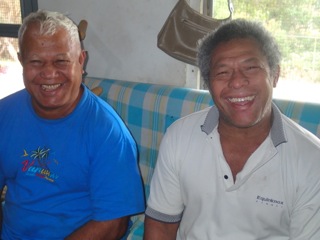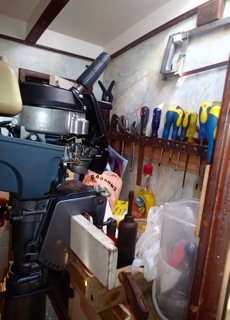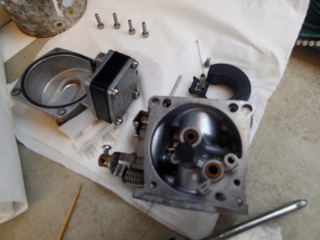navire - 1302 Apr 2016
Nananu I Ra September 22 Janet 17 18.219s 178 13.019e It was just a little trip around the corner to see a man about a fish. David had narrowed identifying yesterday's catch down to somewhere in the bream, warehou or trevally families. We needed to know as many fish here carry a disease called Cegutera. If you eat this fish you get very ill with very severe flu- like symptoms, which can last for months and have no cure. After a phone- consult with Lester on Obsession he recommended Papu.
It was a bit choppy out but we piled into the dinghy with our precious catch in a large black rubbish bag, along with a walu head from the freezer. As we rounded the corner of the island the waves were a tad bigger than was comfortable but we plowed on. We gingerly crossed the coral shelf to shore and I leapt out. My job was to quickly turn the bow of the dinghy into the surf so it wouldn't get swamped but I was too slow and one of the waves leapt in and doused David and the outboard. After tying up to a coconut palm we searched the shore for the house Lester had described. Climbing the hill behind a very flash holiday home we called "Bula bula" at the entrance of a more humble house and were welcomed inside. Papu and some of his family were watching a replay of Japan beating South Africa in the Rugby World Cup. "Sit down, sit down," Papu said, indicating the couch but we sat on the floor with everyone else in proper Fijian style. In Tonga five years ago David struggled to sit cross-legged at all but now at 65 he sits more easily on the floor but standing back up again is difficult.
We met Pae, Papu's wife, and his uncle Kailopa, several of Papu's nine kids, and a grandchild, Pagalu. Little did we know what would later develop with Kailopa.
Papu confirmed our fish a giant trevally and we promptly gave it to him. We still had plenty of walu in the freezer. This was a good start. Out came the kava. A few bowls of this and I was pretty relaxed, the coral navigation stress build up melting away. We talked of how Papu's people migrated to Fiji from Tuvalu sixty years ago and bought an island, Kioa, off the east coast of Vanua Levu. Papu explained he was the caretaker of the big holiday home out front, owned by a wealthy British couple. More kava was offered, and accepted.
We were invited to watch the rugby the next evening, a Fiji vs Australian game. Back down to the dinghy. The wind hadn't abated a single knot. We rowed out over the coral and started the engine which promptly cut out. It probably got salt water in it when I swamped the boat. Sigh, ....I rowed into the wind as David topped up the fuel tank just in case it was a bit low, not so easy as we were bucking up and down in the chop. But no luck, it still kept cutting out. David took over the rowing while I bailed. We rounded the corner and finally ran downwind. Back on board, dinghy safely shipped, I stripped off my soaking clothes and poured a therapeutic whisky.
After David spent the next day as a mechanic working on the outboard, we rowed to shore and walked over to Papu's to watch Australia beat Fiji, with a few beers and more kava. We took popcorn to munch on. Papu's two-year old grandson had never seen it before and kept staring at it but wouldn't take any. Eventually he put some in his mouth and decided it was okay and dafter that it disappeared quickly.
We took a brief trip to the boat to sleep then rowed back in to Papu's to watch New Zealand beat Namibia, being fed tea and pancakes for breakfast. We're getting to know and like Kailopa. He told us his village was having an anniversary celebration of the settlement of the island. This was planned for the end of October complete with feasts and entertainment. Not to be missed. We put it in our calendar. We've worked out the mileage and it's doable.
Back on board Navire David worked on the outboard in the head/workshop and I cleaned the engine area. The day ended with a swim to wash the grease off.
*** We continued waiting for a good weather window to sail southeastward through the next fifty miles of coral. We needed winds from the northerly sector, and clear skies so we could coral-spot. But the north sector winds usually come with a front or a low-pressure system which is accompanied by cloud and that was what was forecast.
We had heaps of boat maintenance to do so were quite happy (and blog post catching up) to linger - and watch more rugby with Papu.
Sept 26 What an excellent day yesterday was. First David succeeded in fixing the outboard engine. This is huge. Its not like you can pop the engine in the boot of the car and drive it to the local outboard mechanic shop. Our outboard and dinghy are our car. We rely heavily on them for getting to shore for anything other than short rowable distances, and these only in light conditions.
To fix the engine we wrestled it into the cockpit and attempted to secure it with ropes so David could dismantle it. But it wouldn't oblige so we then we got it down into the head/workshop and where David stripped down the carburetor, not an easy decision because we had no spares. David had never taken apart a carburetor before and didn't know what he'd find or what he might break, i.e. gaskets, then we'd be stuck without it for several weeks till we got to Savusavu. Being practical people we had two outboard engines however the other one was seized and David had come to the end of his meager mechanical skills (his words).
But it worked. David took the carbie apart, cleaned the jet but could see no obvious blockage and reassembled it. We got the engine back on the dinghy and David went off for a test run, taking the oars just in case. He came back elated, and with an invite for drinks.
"I'm going to be insufferable to live with,'" he said, beaming like a Cheshire cat. What a sense of achievement that must be to bring a mysteriously dead mechanical device back to life.
After a pretty quiet time socially, three new boats turned up in the anchorage, two we'd seen before, two kiwi boats. Clarke Gable from Auckland who we'd met at Kadavu, and Gracias who were moored near us at Vuda Point, but there I'd been too busy to do anything other than say hello as I walked past them. They both dropped by in their dinghies and drinks aboard Clarke Gable were arranged.
Yet another dinghy came by, an English family, and asked us for drinks at their boat. We explained we were otherwise engaged, but they then gathered up the entire anchorage to come to their boat, the biggest in the fleet.
I thought I'd break out a jar of pate as treat for cruisers who were probably down to chippies and peanuts. I paired this with my lovely red onion jam. I even had a shower for the occasion and put on a dress. It felt good to be 'going out'.
We climbed in to the cockpit of a fifty-foot gleaming Farr. I proudly put my tray of pate and accompaniments on the table and the hosts put out.... pate. Turned out they were now from Kerikeri in fact (English imports). They'll be neighbours when we settle in Rawene. They had brought the boat up recently, well stocked with New Zealand goodies. Then Clark Gable arrived with camembert, can't remember when I last had that. They just had a visit to check their business in New Zealand and thought they'd treat us to something from home. Our hosts then produced....brie. It was all very delicious. I really enjoyed hanging out with a bunch of kiwis. Our hosts, Debbie and Chris on Zest, had gorgeous 11 year-old twin boys, Jacob and Thomas who waited on us. We ended up staying for dinner, walu Thai curry. Got home and fell into bed.
*** Still we waited. Our most coral strewn passage to date lay ahead of us, from Nanaui I Ra to Ovalau on the east side of Viti Levu. David spent the morning making satellite charts to put into Open CPN so we could see our course on satellite images. Sadly we found the pictures mostly focused on the coast and there were significant blank areas over the coral we would be navigating. We think the satellite cameras are programmed to only photograph land.
We checked the weather forecast, again.



Add new comment